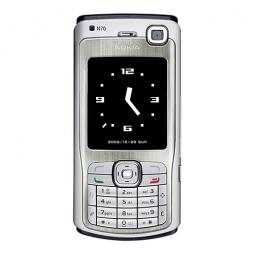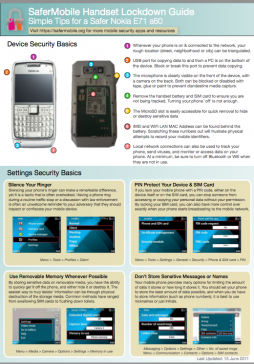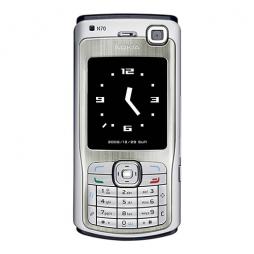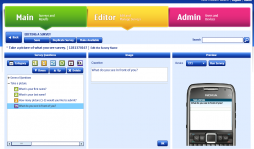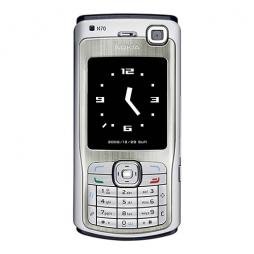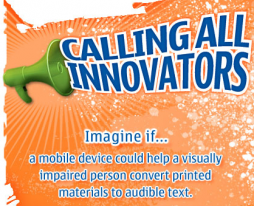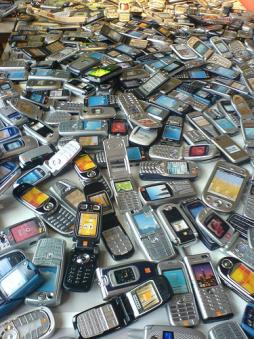nokia
Posted by AnneryanHeatwole on Oct 27, 2011
Today's Mobile Minute brings you coverage on India's mobile growth, smartphones in Asia, the relationship between social media and mobile phones in America, Nokia's global sales report, and the rise of open data projects in the United Kingdom.
- Reuters reports that mobile subscriptions in India are on the rise; in August alone mobile phone operators added 7.34 million new subscribers, bringing the country's total number of mobile subscriptions to 865.71 million. However, now that roughly 70% of the country's population has a mobile phone, the number of new subscribers is rising more slowly than last year as the market becomes more saturated.
- The mobile and smartphone market in the Asia-Pacific region is growing rapidly, and Cellular News has the breakdown of current and projected sales: "The smartphone market is [...] expected to have healthy growth, with 24% share in total handset shipments in 2011, up from 17% in 2010. Smartphone shipments in Asia will see a significant growth of 56% in 2011, which indicates the growing demand for smartphones in emerging Asian markets. Smartphone shipments in Asian markets will see a boost for Android-based smartphones, with market share increasing to 52% in 2011, up from 16% in 2010. As a result, the combined market share of Samsung and HTC, the leading Android-based smartphone makers in Asia, will swell from 11% in 2010 to 24% in 2011."
Posted by MelissaLoudon on Oct 14, 2011
Securing your Mobile Email data sheet 2098 Views
Abstract:
Email wasn’t designed with security in mind. Unless you take steps to protect your communication, emails are sent in plain text - and so are your email account username and password.
At the same time, if you and your recipient are taking the appropriate security precautions, mobile email can be a secure and reliable alternative to other forms of mobile communication. If you have data service for your mobile, encrypted email can replace text messaging, and if you aren’t able to access a website securely to upload content - photos or videos for example - getting it to a trusted contact as an email attachment can be a safer alternative.
Email wasn’t designed with security in mind. Unless you take steps to protect your communication, emails are sent in plain text - and so are your email account username and password.
At the same time, if you and your recipient are taking the appropriate security precautions, mobile email can be a secure and reliable alternative to other forms of mobile communication. If you have data service for your mobile, encrypted email can replace text messaging, and if you aren’t able to access a website securely to upload content - photos or videos for example - getting it to a trusted contact as an email attachment can be a safer alternative.
This article suggests the following tactics for improving the security of your mobile email:
Email security basics
Even if you’re not using encrypted email, you can take some basic precautions to improve your email security. For example
Posted by AnneryanHeatwole on Aug 01, 2011
The Mobile Minute is back with the latest mobile news. What's happening today? Nielsen Wire looks at smartphone penetration in Asia, RIM lays off 11% of its worldwide workforce, CGAP investigates how network operators can incorporate mobile financial services into their operations, [x]Cube Labs turns Android's history into an infographic, and Read Write Web looks into the latest developments in the use of near field communication technology for mobile payments.
- Curious about the smartphone market in Asia? Nielsen Wire looks at the rapid growth of smartphones in Asia. Although current smartphone penetration in the region is less than 20%, a Nielsen survey of consumers revealed that nearly half of respondents plan to buy a smartphone within the next year. Nielsen Wire investigates what the anticipated increase in smartphone ownership will mean for how people access the Internet, how network operators will price their data plans, and how mobile advertising will adjust to a new market.
- Wired reports that RIM (the makers of BlackBerry devices) announced on July 25th their plans to lay off 2000 employees, roughly 11% of its worldwide workforce. The move comes as RIM has lost market share to the growing popularity of newer operating systems like Apple's iOS and Google's Android.
- CGAP's "How to Run with Mobile Money and Not Fall" article examines how mobile network operators can incorporate mobile financial services into their current business models. Some of the advice for successfully incorporating mobile money services includes using multiple distribution methods (such as both on-phone purchases and traditional street airtime sellers) and getting support from/sharing knowledge among multiple departments.
- If you like charts and graphs, check out this history of the Android operating system. Covering everything from its founding date (2003), to the Google buyout (2005), to the launch of the first Android device (2008), to present day releases, the infographic maps out each update in Android's development.
- Near field communication (NFC) technology allows smartphone users to transmit information to nearby contacts. Read Write Web recently investigated some of the new developments in the NFC field for turning smartphones into credit cards. The first article looks at how the company Isis partnered with four major American credit card companies (Visa, MasterCard, American Express, and Discover) to develop wireless payments. The second article looks at the Jumio payment company's launch of Netswipe, which "turns any webcam into a credit card reader, both on the desktop and on mobile."
[Mobile Minute Disclaimer: The Mobile Minute is a quick round-up of interesting stories that have come across our RSS and Twitter feeds to keep you informed of the rapid pace of innovation. Read them and enjoy them, but know that we have not deeply investigated these news items. For more in-depth information about the ever-growing field of mobile tech for social change, check out our blog posts, white papers and research, how-tos, and case studies.
Image courtesy Flickr user QiFei
Posted by SaferMobile on Jun 29, 2011
Despite the smartphone craze of the past 5 years, featurephones are still king in much of the world. From the perspective of activists, rights defenders, and journalists, they cannot be ignored. And feature phones have plenty of built-in capability to help users stay safer. During the course of our research, we've uncovered valuable features that even the most experienced users may not be aware of.
As a part of SaferMobile, a project of MobileActive.org, we've focused on documenting the most important ways that a user can lock down a mobile handsets. No external apps or special tools are required, just a charged battery. We've condensed these tips into single-page, device-specific reference guides for a variety of makes & models that get straight to the point. And yes, we made sure to cover smartphones and featurephones.
Posted by AnneryanHeatwole on Nov 02, 2010
Today's Mobile Minute brings you the latest mobile news. Mobile Commons helps people find voting stations in the U.S. via SMS, Nokia pushes for rural users, NPR's mobile services win them an Online Journalism Award, and seven out of ten people store sensitive data on their mobile phones – without security measures.
- Today is election day in the United States, so if you want to find out where your nearest polling station is, check out the Mobile Polling Place Locator by Mobile Commons. Text WHERE (for English instructions) or DONDE (for Spanish instructions) to 30644. You'll be prompted to enter your home address, and then be directed to your local polling center.
- The New York Times reported on Nokia's Ovi Life Tools program, which uses basic text messages to transmit market and agricultural data to rural mobile owners. The program has already been successful in India, and now Nokia is gearing up to launch a similar program in Nigeria.
- The BBC reported on a study from security firm Juniper Networks that found bad news for users worried about mobile security: "In its research covering 6,000 participants spread over 16 countries, Juniper found that 61% of all reported smartphone infections were spyware, capable of monitoring communication from the device. A further 17% were text message Trojans that charge fees to a device's account holder."
[Mobile Minute Disclaimer: The Mobile Minute is a quick round-up of interesting stories that have come across our RSS and Twitter feeds to keep you informed of the rapid pace of innovation. Read them and enjoy them, but know that we have not deeply investigated these news items. For more in-depth information about the ever-growing field of mobile tech for social change, check out our blog posts, white papers and research, how-tos, and case studies.
Image courtesy Flickr user QiFei
Posted by MelissaUlbricht on Oct 22, 2010
Nokia S60 3rd Edition Video Editor data sheet 6204 Views
Organization that developed the Tool:
Main Contact:
Not listed, visit http://www.nokiausa.com/ or local Nokia site.
Problem or Need:
The Nokia S60 3rd edition video editor comes standard on Nokia N95 phones. The video editor is a simple video editing tool that allows a user to cut clips, add special effects, credits, and sound to video clips, and publish clips to a website, all through a mobile phone.
Brief Description:
The Nokia S60 3rd edition video editor comes standard on Nokia N95 phones. It is part of the S60 Platform (formerly Series 60 User Interface) - a software platform for mobile phones that run on Symbian OS. The video editor is a simple video editing tool that allows a user to cut clips, add special effects, credits, and sound to video clips, and publish clips to a website, all through a mobile phone.
A video tutorial is posted on YouTube and AllAboutSymbian.com. It can also be downloaded and installed free at this site.
Tool Category:
App resides and runs on a mobile phone
Key Features :
The Nokia S60 3rd edition video editor comes standard on Nokia N95 phones. It allows a user to cut clips, add sound, transitions, credits, and special effects such as slow motion or black and white. A user can create "micro-movies." The final version of the movie can be saved on the phone itself and sent via MMS, e-mail, or uploaded to a website.
Main Services:
Multi-Media Messaging (MMS) or other Multi-Media
Reviews/Evaluations:
http://www.allaboutsymbian.com/features/item/Editing_a_Video_Presentation_on_teh_N95.php
http://www.allaboutsymbian.com/media/item/Videocast_11_Video_editing_on_the_Nokia_N95.p
hp
http://www.youtube.com/watch?v=RlhLb0MOn1s
Is the Tool's Code Available?:
Is an API available to interface with your tool?:
Posted by AnneryanHeatwole on Oct 19, 2010
Today's Mobile Minute brings you news about the continuous lack of Facebook privacy, the disagreement between IDC and Nokia on Nokia sales figures in India, a ranking of the top five free Android apps for journalists, a TNS study that found social media trumps e-mail as the most popular use for online mobile activity, and mapping indoor spaces with smartphone apps.
Posted by AnneryanHeatwole on Sep 08, 2010
Today's Mobile Minute's coverage will feature release of the data-aggregating program SwiftRiver, feature phones' allure in developing countries, Nokia's entrance into the dual SIM card market, a new book that investigates how ICTs will have an effect on politics and culture in the Muslim world, and how RIM's response delayed India's proposed ban on BlackBerry services.
Posted by AnneryanHeatwole on Aug 11, 2010
Today's Mobile Minute brings you coverage about contactless mobile payments in the U.S., a report on trends in technology and health, research that covers how mobiles can help economic development in Africa and the challenges that are hindering that development, a data gathering platform from Nokia that is now open-source, and the announcement of the mHealth Summit's keynote speaker.
Posted by PrabhasPokharel on Aug 10, 2010
Nokia Data Gathering, a Nokia-built software tool for mobile data collection, recently open-sourced its code. The software has two parts: a server-side tool that can be used to create forms and maintain a database, and a handset client for field workers to use for mobile, in-the-field data collection. Both pieces are licensed under the GPL version 2. The project site is available at Forum Nokia, and invites third-party patches.
Posted by AnneryanHeatwole on Jul 27, 2010
Today's Mobile Minute brings you an interview with Indrani Medhi on her work with text-free interface technology, an SMS case study from Toronto's The Globe and Mail, a look at race and digital technology, Nokia's falling profits, and which mobile domains are most popular.
Posted by KatrinVerclas on Sep 24, 2008
Forum Nokia has announced a new global contest: "Calling All Innovators" for developers to create mobile applications that will help to better society. Nokia will award up to USD 150,000 in cash and prizes, in addition to helping the winning developers distribute their mobile applications.
In its announcement of the contest, Nokia notes that
Posted by CorinneRamey on Apr 22, 2008
In the United States, a used mobile phone is likely to end up in the trash can, or more likely, in the back of a desk drawer for several years, collecting dust. But in the rest of the world, this just isn't the case. Mobile phones -- or even parts of mobile phones -- are reused, recycled, and refurbished.
Jan Chipchase, a phone anthropologist for Nokia, has seen the way that old mobile phones transform into new ones while traveling for Nokia around the world. According to this CNET News article, Chipchase and his team (MobileActive wrote about Younghee Jung, an anthropologist who works with Chipchase, here) have found that refurbishing phones is a booming market in developing countries, with small businesses springing up that sell phone parts, repair manuals, and pirated versions of the newest software.
Posted by CorinneRamey on Feb 08, 2008
With mobile phones become ubiquitous in developing countries and emerging markets, phone manufacturers istening to the unique design needs of users there. Younghee Jung , an anthropologist working for Nokia, spoke about the design possibilities for improving phones for the developing world at the LIFT conference in Geneva, Switzerland that addresses the "challenges and opportunities of technology in society."
In a video presentation, Younghee speaks about the research that Nokia conducted in shantytowns in three cities: Mumbia, India, Rio de Janeiro, Brazil and Accra, Ghana. The team conducted ethnographic research, conducted street surveys, and sponsored an "open studio" contest in which they asked people to design their ideal mobile phone.
Posted by KatrinVerclas on Dec 19, 2007
Mobile social adverts - and the winner is here. MTV Networks International and Nokia teamed up earlier this year in a new campaign called MTV Switch to to inform, entertain and encourage climate-conscious behaviour amongst global youth, driving traffic to MTV.
During the 2007 Cannes Lions Advertising Festival, Young Creative Film Competitors on a 48 hour mission to shoot a 30-second advert using the Nokia N93i to be used on TV, mobile and the web that encourages 15-25 year olds to adopt new energy-saving lifestyles, making it cool to be green. All submissions shot on the Nokia N93 are here - judge for yourself!
Posted by CorinneRamey on Oct 26, 2007
Reuters and Nokia Research Center have teamed up to advance the usage of mobile journalism with the release of a new mobile toolkit and reporting try-out. Although the initiative is currently aimed at professional reporters, the project has implications for citizen journalists around the world.
Posted by CorinneRamey on Sep 28, 2007
The rural mobile market is growing, and carriers are working to meet the unique demands and challenges of this sector of the population. Even in the poorest countries -- like Sierra Leone, which ranks 176 out of 177 countries on the UN's 2006 Human Development Index -- mobile phones have become a growing necessity, creating a unique set of cultural norms and practices. According to a recent article in Africa News, "It is no secret that Sierra Leone has one of the largest mobile network services although said to be the least developed country in the West African Sub-Region." Mobile service in Sierra Leone is covered by three carriers -- Mobitel, Celtel and Millicom. Although the network has increased dramatically since the civil war ended in 2000, there is still demand from rural customers for more comprehensive coverage in poor rural areas.
Posted by KatrinVerclas on Jun 20, 2007
Nokia and Vodafone have launched a new wiki, Share Ideas, designed to help share ideas about how to use mobile phones for civil society. Please check it out!
